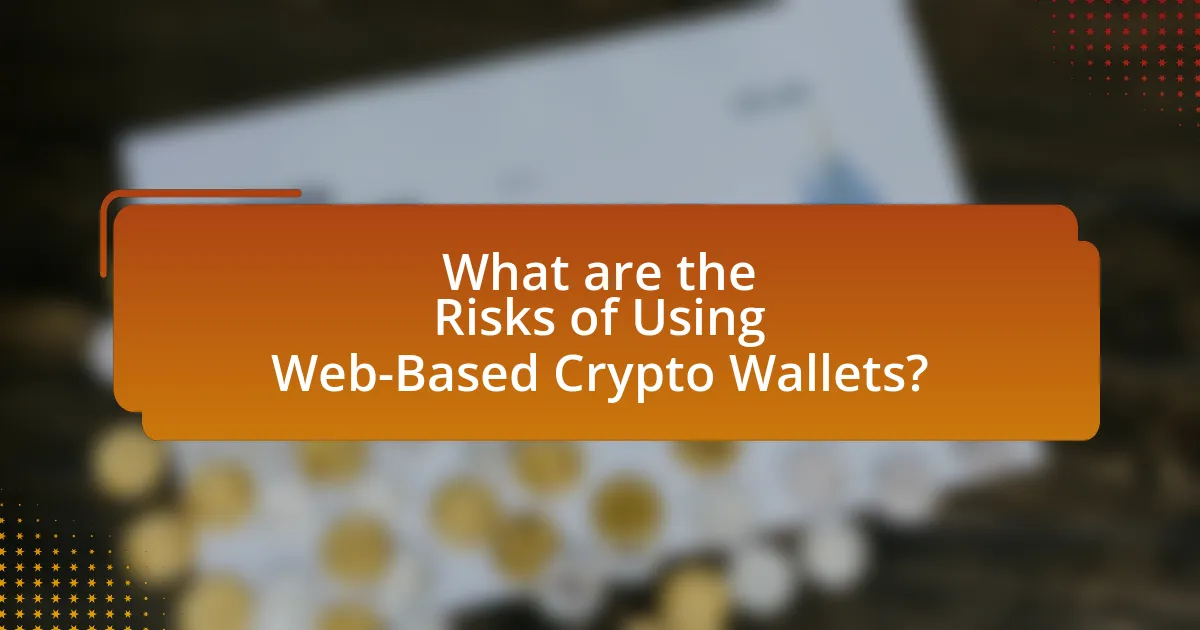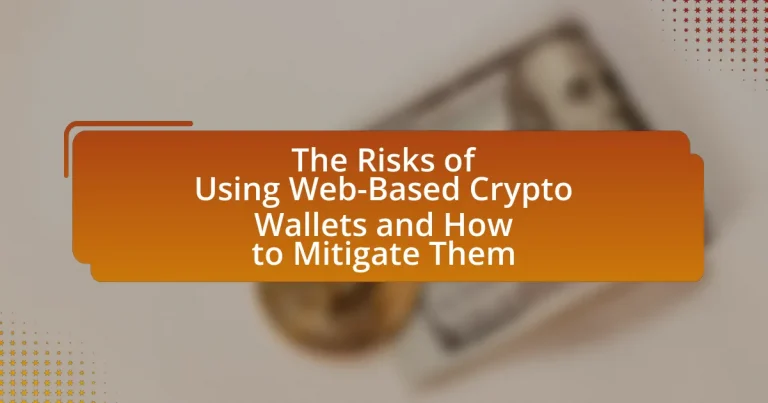Web-based crypto wallets are digital storage solutions for cryptocurrencies that present significant risks, including hacking, phishing attacks, and loss of private keys. These wallets, often managed by third-party services, are vulnerable to unauthorized access and theft, with billions lost to cybercrime in recent years. Users face additional challenges from regulatory compliance and the potential consequences of relying on less secure platforms. To mitigate these risks, best practices such as enabling two-factor authentication, using strong passwords, and regularly monitoring wallet activity are essential for enhancing security and protecting digital assets.

What are the Risks of Using Web-Based Crypto Wallets?
Web-based crypto wallets pose several risks, including susceptibility to hacking, phishing attacks, and loss of private keys. These wallets are often stored on servers controlled by third parties, making them attractive targets for cybercriminals. According to a report by Chainalysis, in 2021, over $3.2 billion was stolen from cryptocurrency exchanges and wallets, highlighting the vulnerability of web-based solutions. Additionally, users may fall victim to phishing schemes, where attackers impersonate legitimate services to steal credentials. Furthermore, if a user loses access to their private keys, they may permanently lose access to their funds, as many web-based wallets do not offer recovery options.
How do security vulnerabilities affect web-based crypto wallets?
Security vulnerabilities significantly compromise web-based crypto wallets by exposing them to unauthorized access and potential theft of digital assets. These vulnerabilities can arise from inadequate encryption, poor coding practices, or outdated software, allowing hackers to exploit weaknesses. For instance, a 2021 report by CipherTrace indicated that over $1.9 billion was lost to crypto theft, much of which involved web wallets with security flaws. Such breaches not only result in financial loss for users but also damage the overall trust in cryptocurrency platforms.
What types of security threats are most common?
The most common types of security threats associated with web-based crypto wallets include phishing attacks, malware, and hacking. Phishing attacks involve deceptive communications that trick users into revealing sensitive information, with a reported increase in such incidents by 400% in recent years. Malware can compromise devices to steal private keys or credentials, while hacking incidents have led to significant losses, with over $1.9 billion stolen from crypto exchanges in 2020 alone. These threats highlight the vulnerabilities inherent in using web-based wallets for cryptocurrency storage.
How can phishing attacks compromise wallet security?
Phishing attacks can compromise wallet security by tricking users into revealing their private keys or login credentials. Attackers often create fake websites or emails that closely resemble legitimate services, leading users to input sensitive information. According to the Anti-Phishing Working Group, there were over 200,000 reported phishing attacks in 2020 alone, highlighting the prevalence of this threat. When users unknowingly provide their information to these fraudulent platforms, attackers gain unauthorized access to their wallets, resulting in potential financial loss.
What are the implications of relying on third-party services?
Relying on third-party services can lead to significant security vulnerabilities and loss of control over assets. When users depend on external providers for crypto wallet services, they expose themselves to risks such as data breaches, service outages, and potential fraud. For instance, a 2021 report by Chainalysis indicated that over $2.8 billion was lost to hacks targeting centralized exchanges and wallets, highlighting the dangers of entrusting sensitive information to third parties. Additionally, third-party services may implement varying security measures, which can result in inconsistent protection levels for users’ assets.
How does the trustworthiness of a service provider impact user safety?
The trustworthiness of a service provider directly impacts user safety by influencing the likelihood of data breaches and fraud. A reliable service provider implements robust security measures, such as encryption and two-factor authentication, which protect user information from unauthorized access. For instance, a study by the Cybersecurity & Infrastructure Security Agency (CISA) found that organizations with high trust ratings experienced 50% fewer security incidents compared to those with lower trust ratings. This correlation highlights that trustworthy providers not only foster user confidence but also significantly reduce the risk of cyber threats, thereby enhancing overall user safety.
What happens if a service provider goes offline or is hacked?
If a service provider goes offline or is hacked, users may lose access to their funds and sensitive information may be compromised. When a service provider is offline, transactions cannot be processed, and users may experience delays in accessing their assets. In the case of a hack, attackers can steal private keys or personal data, leading to unauthorized access to user accounts. According to a report by Chainalysis, in 2021, over $3.2 billion was stolen from DeFi protocols, highlighting the significant risks associated with security breaches in web-based crypto wallets.
What legal and regulatory risks should users be aware of?
Users should be aware of several legal and regulatory risks associated with web-based crypto wallets, including compliance with anti-money laundering (AML) and know your customer (KYC) regulations. These regulations require users to provide personal identification information, and failure to comply can result in account suspension or legal penalties. Additionally, users may face risks related to jurisdictional regulations, as different countries have varying laws governing cryptocurrency transactions, which can lead to legal uncertainties. For instance, in 2021, the Financial Action Task Force (FATF) issued guidelines that many countries adopted, emphasizing the need for crypto service providers to adhere to strict regulatory frameworks. This highlights the importance of understanding local laws to avoid potential legal repercussions.
How do different jurisdictions regulate web-based crypto wallets?
Different jurisdictions regulate web-based crypto wallets through a combination of licensing requirements, anti-money laundering (AML) regulations, and consumer protection laws. For instance, in the United States, the Financial Crimes Enforcement Network (FinCEN) classifies crypto wallet providers as money services businesses (MSBs), requiring them to register and comply with AML regulations. In the European Union, the Fifth Anti-Money Laundering Directive (5AMLD) mandates that crypto wallet providers conduct customer due diligence and report suspicious activities. Meanwhile, countries like Japan have established a licensing framework under the Payment Services Act, which requires crypto wallet operators to register with the Financial Services Agency (FSA) and adhere to strict security standards. These regulatory frameworks aim to mitigate risks associated with web-based crypto wallets, such as fraud and money laundering, while promoting consumer trust and market integrity.
What are the potential consequences of non-compliance?
The potential consequences of non-compliance with regulations governing web-based crypto wallets include significant financial penalties, legal repercussions, and loss of customer trust. Financial penalties can reach millions of dollars, as seen in cases where companies failed to adhere to anti-money laundering (AML) and know your customer (KYC) regulations. Legal repercussions may involve lawsuits or criminal charges against responsible individuals, which can lead to imprisonment. Additionally, non-compliance can result in reputational damage, causing customers to withdraw their funds and seek more secure alternatives, ultimately leading to a decline in business viability.

How Can Users Mitigate Risks Associated with Web-Based Crypto Wallets?
Users can mitigate risks associated with web-based crypto wallets by implementing strong security practices. These practices include enabling two-factor authentication (2FA), which adds an extra layer of protection by requiring a second form of verification beyond just a password. Additionally, users should regularly update their passwords and use complex, unique passwords for their wallets to reduce the likelihood of unauthorized access.
Furthermore, users should be cautious about phishing attacks by verifying the authenticity of websites before entering sensitive information. Research indicates that phishing is a common method used to compromise crypto wallets, with a significant percentage of users falling victim to such scams. Lastly, users should consider storing large amounts of cryptocurrency in hardware wallets, which are less susceptible to online threats compared to web-based wallets.
What best practices should users follow for enhanced security?
Users should follow several best practices for enhanced security when using web-based crypto wallets. First, they should enable two-factor authentication (2FA) to add an extra layer of protection against unauthorized access. According to a study by Google, 2FA can block 99.9% of automated attacks. Second, users must create strong, unique passwords and change them regularly to reduce the risk of password-related breaches. The National Institute of Standards and Technology (NIST) recommends using passwords that are at least 12 characters long and include a mix of letters, numbers, and symbols. Third, users should regularly update their software and wallet applications to protect against vulnerabilities, as outdated software can be an easy target for hackers. Additionally, users should be cautious of phishing attempts and only access their wallets through official websites or apps. Research from the Anti-Phishing Working Group indicates that phishing attacks are a leading cause of security breaches in the crypto space. Finally, users should consider using hardware wallets for storing significant amounts of cryptocurrency, as these devices are less susceptible to online threats.
How important is two-factor authentication for wallet security?
Two-factor authentication (2FA) is crucial for wallet security as it significantly reduces the risk of unauthorized access. By requiring a second form of verification, such as a code sent to a mobile device, 2FA adds an additional layer of protection beyond just a password. Research indicates that accounts with 2FA enabled are 99.9% less likely to be compromised, highlighting its effectiveness in safeguarding digital assets.
What role does strong password management play in protecting assets?
Strong password management is crucial in protecting assets, particularly in the context of web-based crypto wallets. Effective password management reduces the risk of unauthorized access, which is a primary threat to digital assets. According to a study by the Cybersecurity & Infrastructure Security Agency, 81% of data breaches are linked to weak or stolen passwords. By employing strong, unique passwords and utilizing password managers, users can significantly enhance their security posture, making it more difficult for attackers to compromise their accounts and access sensitive information.
How can users choose safer web-based crypto wallets?
Users can choose safer web-based crypto wallets by selecting wallets that offer strong security features such as two-factor authentication (2FA), end-to-end encryption, and cold storage options. Wallets like Coinbase and Binance are known for implementing these security measures, which significantly reduce the risk of unauthorized access and hacking incidents. Additionally, users should verify the wallet’s reputation by checking reviews and security audits, as well as ensuring that the wallet complies with regulatory standards. According to a report by CipherTrace, over $1.9 billion was lost to crypto theft in 2020, highlighting the importance of selecting wallets with robust security protocols.
What features should users look for in a secure wallet?
Users should look for features such as strong encryption, two-factor authentication, and a user-friendly interface in a secure wallet. Strong encryption protects sensitive data by converting it into a format that is unreadable without a decryption key, ensuring that unauthorized access is minimized. Two-factor authentication adds an extra layer of security by requiring a second form of verification, such as a text message or authentication app, which significantly reduces the risk of unauthorized access. A user-friendly interface allows users to navigate the wallet easily, which is crucial for managing assets securely and efficiently. These features collectively enhance the security and usability of a wallet, making it a safer option for storing cryptocurrencies.
How can user reviews and ratings inform wallet selection?
User reviews and ratings can significantly inform wallet selection by providing insights into the experiences of other users regarding security, usability, and customer support. For instance, a wallet with high ratings often indicates a reliable platform that has successfully met user needs, while negative reviews may highlight potential security vulnerabilities or poor customer service. Research shows that 84% of consumers trust online reviews as much as personal recommendations, underscoring their importance in decision-making. Therefore, analyzing user feedback can help potential users identify trustworthy wallets and avoid those with a history of issues, ultimately mitigating risks associated with web-based crypto wallets.

What Specific Strategies Can Enhance the Safety of Web-Based Crypto Wallets?
To enhance the safety of web-based crypto wallets, users should implement multi-factor authentication (MFA), utilize strong, unique passwords, and regularly update software. Multi-factor authentication adds an extra layer of security by requiring additional verification beyond just a password, significantly reducing the risk of unauthorized access. Strong, unique passwords prevent easy guessing or brute-force attacks, while regular software updates ensure that any vulnerabilities are patched promptly. According to a report by the Cybersecurity & Infrastructure Security Agency, using MFA can block over 99% of automated attacks, highlighting its effectiveness in securing online accounts.
How can regular updates and maintenance improve wallet security?
Regular updates and maintenance significantly enhance wallet security by addressing vulnerabilities and implementing the latest security protocols. Software developers frequently release updates to patch known security flaws, which, if left unaddressed, can be exploited by cybercriminals. For instance, a study by the Ponemon Institute found that 60% of data breaches are linked to unpatched vulnerabilities. Additionally, regular maintenance ensures that the wallet software remains compatible with evolving security standards, thereby reducing the risk of unauthorized access. By consistently updating and maintaining wallets, users can protect their assets from emerging threats and enhance overall security.
What are the benefits of keeping software up to date?
Keeping software up to date enhances security, improves performance, and ensures compatibility with other systems. Regular updates often include patches for vulnerabilities that could be exploited by cybercriminals, thereby reducing the risk of data breaches. For instance, a report from the Cybersecurity & Infrastructure Security Agency (CISA) indicates that 85% of successful cyberattacks exploit known vulnerabilities for which patches are available. Additionally, updates can introduce new features and optimizations that enhance user experience and system efficiency. Therefore, maintaining updated software is crucial for safeguarding sensitive information, particularly in the context of web-based crypto wallets, where security is paramount.
How does regular monitoring of wallet activity help in risk management?
Regular monitoring of wallet activity enhances risk management by enabling the detection of unusual transactions and potential security breaches in real-time. This proactive approach allows users to identify unauthorized access or fraudulent activities quickly, minimizing potential losses. For instance, a study by Chainalysis in 2021 indicated that timely detection of suspicious transactions can reduce the impact of hacks by up to 80%. By consistently reviewing wallet activity, users can implement immediate corrective actions, such as changing passwords or freezing accounts, thereby safeguarding their assets effectively.
What are the common troubleshooting steps for wallet security issues?
Common troubleshooting steps for wallet security issues include verifying the wallet’s software is up to date, ensuring strong passwords are used, enabling two-factor authentication, and checking for phishing attempts. Keeping the wallet software updated protects against vulnerabilities, as outdated versions may have security flaws. Strong passwords reduce the risk of unauthorized access, while two-factor authentication adds an extra layer of security. Additionally, users should be vigilant against phishing attempts, which can compromise wallet security by tricking users into revealing sensitive information.
How can users recover from a compromised wallet situation?
Users can recover from a compromised wallet situation by immediately transferring their remaining funds to a secure wallet and changing all associated passwords. This action prevents further unauthorized access and secures any assets that have not yet been compromised. Additionally, users should enable two-factor authentication on their accounts to enhance security. According to cybersecurity experts, prompt action is crucial; delaying can lead to further losses, as compromised wallets can be exploited quickly.
What should users do if they suspect fraudulent activity?
Users should immediately report suspected fraudulent activity to the relevant financial institution or platform. This action is crucial because timely reporting can help mitigate potential losses and initiate investigations. Additionally, users should change their passwords and enable two-factor authentication to secure their accounts. According to the Federal Trade Commission, reporting fraud can also assist in tracking and preventing further fraudulent activities.


